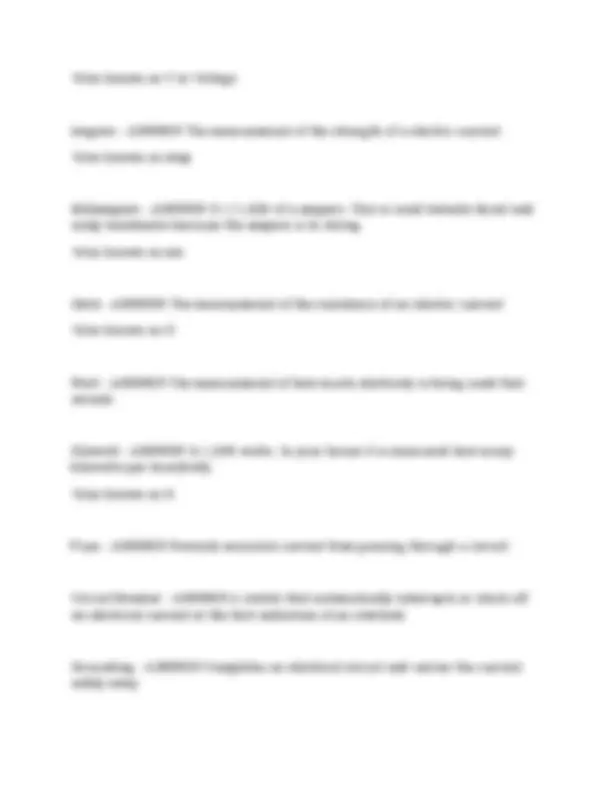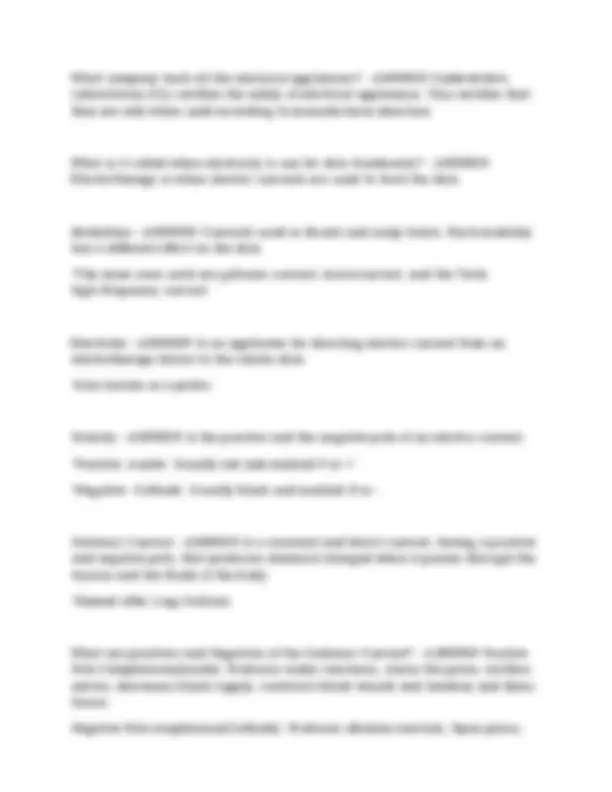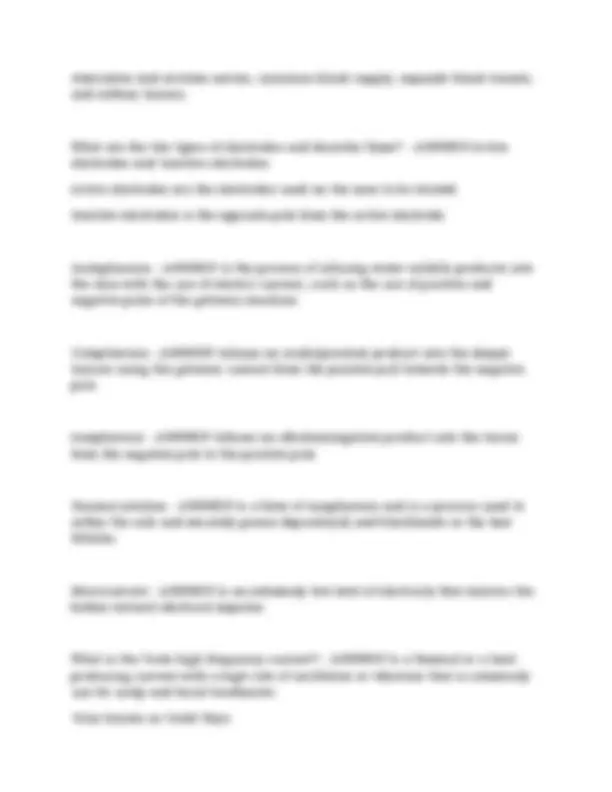





Study with the several resources on Docsity

Earn points by helping other students or get them with a premium plan


Prepare for your exams
Study with the several resources on Docsity

Earn points to download
Earn points by helping other students or get them with a premium plan
Community
Ask the community for help and clear up your study doubts
Discover the best universities in your country according to Docsity users
Free resources
Download our free guides on studying techniques, anxiety management strategies, and thesis advice from Docsity tutors
Chapter 13_ Electricity Milady Cosmetology Revision Questions With Accurate Answers
Typology: Exams
1 / 7

This page cannot be seen from the preview
Don't miss anything!




Electricity - ANSWER The movement of particles around an atom that creates pure energy.
Define: Electric Current - ANSWER The flow of electricity along a conductor.
Conductor - ANSWER Any material that conducts electricity. Meaning that electricity will pass threw the material easily.
*Most metal are good conductors
*Copper is a good conductor
Nonconductor - ANSWER Is a material does not transmit electricity. Meaning does not allow electricity to flow threw it.
*Also referred to as an Insulator
Complete Electric Circuit - ANSWER The path of negative and positive electric currents moving from the generating source through the conductors and back to the generating source.
How fast does lightning travel? - ANSWER Lightning can travel up to speeds of 60,000 miles per hour threw the air.
What are the two types of electric currents? - ANSWER 1)Direct Current (DC)
2)Alternating Current (AC)
Direct Current - ANSWER Is a constant even-flowing current that travels in one direction only and is produced by chemical means.
*Flashlights, cell phones, telephones, cordless hairstyling tools.
Alternating Current - ANSWER Is a rapid and interrupted current, flowing first in one direction then I the opposite direction, it is produced by mechanical means and changes direction 60 times per seconds.
*Corded hair dryers, Curling irons, Table lamps
Converter - ANSWER Is an apparatus that changes the direct current to alternating current.
Rectifier - ANSWER Is an apparatus that changes the alternating current to direct current.
How fast is electricity? - ANSWER Electricity is very fast: 186,000 miles per second. If you were to travel that fast, you could go around the world eight times in the time it takes you to turn a light on.
Name some differences between direct and alternating current. - ANSWER Direct Current:
*Constant, even-flowing, Travels in one direction, and produced by chemical means.
Alternating Current:
*Rapid and interrupted flow, Travels in two directions, and produced by mechanical means.
Volt - ANSWER Is the unit that measures the pressure of force that pushes electric current forward through a conductor.
What company tests all the electrical appliances? - ANSWER Underwriters Laboratories (UL) certifies the safety of electrical appliances. This certifies that they are safe when used according to manufactures direction.
What is it called when electricity is use for skin treatments? - ANSWER Electrotherapy is when electric currents are used to treat the skin.
Modalities - ANSWER Currents used in facials and scalp treats. Each modality has a different effect on the skin.
*The main ones used are galvanic current, microcurrent, and the Tesla high-frequency current.
Electrode - ANSWER Is an applicator for directing electric current from an electrotherapy device to the clients skin.
*Also known as a probe
Polarity - ANSWER Is the positive and the negative pole of an electric current.
*Positive: Anode: Usually red and marked P or +
*Negative: Cathode: Usually black and marked N or -
Galvanic Current - ANSWER Is a constant and direct current, having a positive and negative pole, that produces chemical changed when it passes through the tissues and the fluids of the body.
*Named after Luigi Galvani
What are positives and Negatives of the Galvanic Current? - ANSWER Positive Pole Cataphoresis(Anode): Produces acidic reactions, closes the pores, soothes nerves, decreases blood supply, contracts blood vessels and hardens and firms tissue.
Negative Pole Anaphoresis(Cathode): Produces alkaline reaction, Open pores,
stimulates and irritates nerves, increases blood supply, expands blood vessels, and softens tissues.
What are the two types of electrodes and describe them? - ANSWER Active electrodes and Inactive electrodes:
Active electrodes are the electrodes used on the area to be treated.
Inactive electrodes is the opposite pole from the active electrode.
Iontophoresis - ANSWER Is the process of infusing water-soluble products into the skin with the use of electric current, such as the use of positive and negative poles of the galvanic machine.
Cataphoresis - ANSWER Infuses an acidic(positive) product into the deeper tissues using the galvanic current from the positive pull towards the negative pole.
Anaphoresis - ANSWER Infuses an alkaline(negative) product into the tissue from the negative pole to the positive pole.
Denincrustation - ANSWER Is a form of anaphoresis and is a process used to soften the sick and emulsify grease deposits(oil) and blackheads in the hair follicles.
Microcurrent - ANSWER Is an extremely low level of electricity that mirrors the bodies natural electrical impulse.
What is the Tesla high-frequency current? - ANSWER Is a thermal or a heat producing current with a high rate of oscillation or vibration that is commonly use for scalp and facial treatments.
*Also known as Violet Rays
Ultraviolet Light - ANSWER Is a invisible light that has short wavelengths(giving higher energy), is less penetrating that visible light, causes chemical reaction to happen more quickly than visible light, produces less heat then visible light and kills some germs.
*Three types: Ultraviolet A(UVA) penetrates directly into the dermis, damaging collagen and elastin, Ultraviolet B(UVB) Burning rays(Sunburns), and Ultraviolet C(UVC) is blocked out by the ozone layer.
*Also known as cold light, UV and actinic light
Catalyst - ANSWER Are substances that speed up chemical reactions, some use heat as an energy source while others use light.
Light Therapy - ANSWER Is and application of light rays to the skin for the treatment of wrinkles, capillaries, pigmentation, or hair removal.
*Also known as Phototherapy.
What does Laser stand for. - ANSWER Laser stands for Light Amplification Stimulation Emission of Radiation.
*All lasers work by photothermolysis, a process that turns the light from the laser into heat.
Light-Emitting Diode - ANSWER Is a medical device used to reduce acne, increase skin circulation and improve collage of the skin.
*Also know as LED
Intense Pulse Light - ANSWER A medical device that uses multiple colors and wavelengths(broad spectrum) of focused light to treat spider veins, hyperpigmentation, rosacea and redness, wrinkles and ex.